Financial Accounting Report: Fair Value and Valuation Techniques
VerifiedAdded on 2020/07/22
|13
|3631
|48
Report
AI Summary
This report delves into the debate between fair value and historical cost accounting, a significant discussion in accounting literature. It explores the application of International Financial Reporting Standards (IFRS) and examines the selection between these accounting practices through a quasi-experiment. The report discusses fair value measurement based on an "exit price" notion and the fair value hierarchy, emphasizing market-based valuation. It covers the measurement of fair value, including the specific asset or liability, valuation basis, and valuation techniques. Furthermore, the report analyzes the valuation practices of three companies—Unilever plc, American Tower Corporation, and BHP Billiton—listed on different stock exchanges, examining their balance sheets and accounting methods. The analysis includes the benefits and challenges of fair value measurement and a detailed examination of the valuation practices employed by each company, considering their adherence to accounting standards and the treatment of assets, liabilities, and equity. The report also mentions valuation techniques like market, cost, and income approaches.
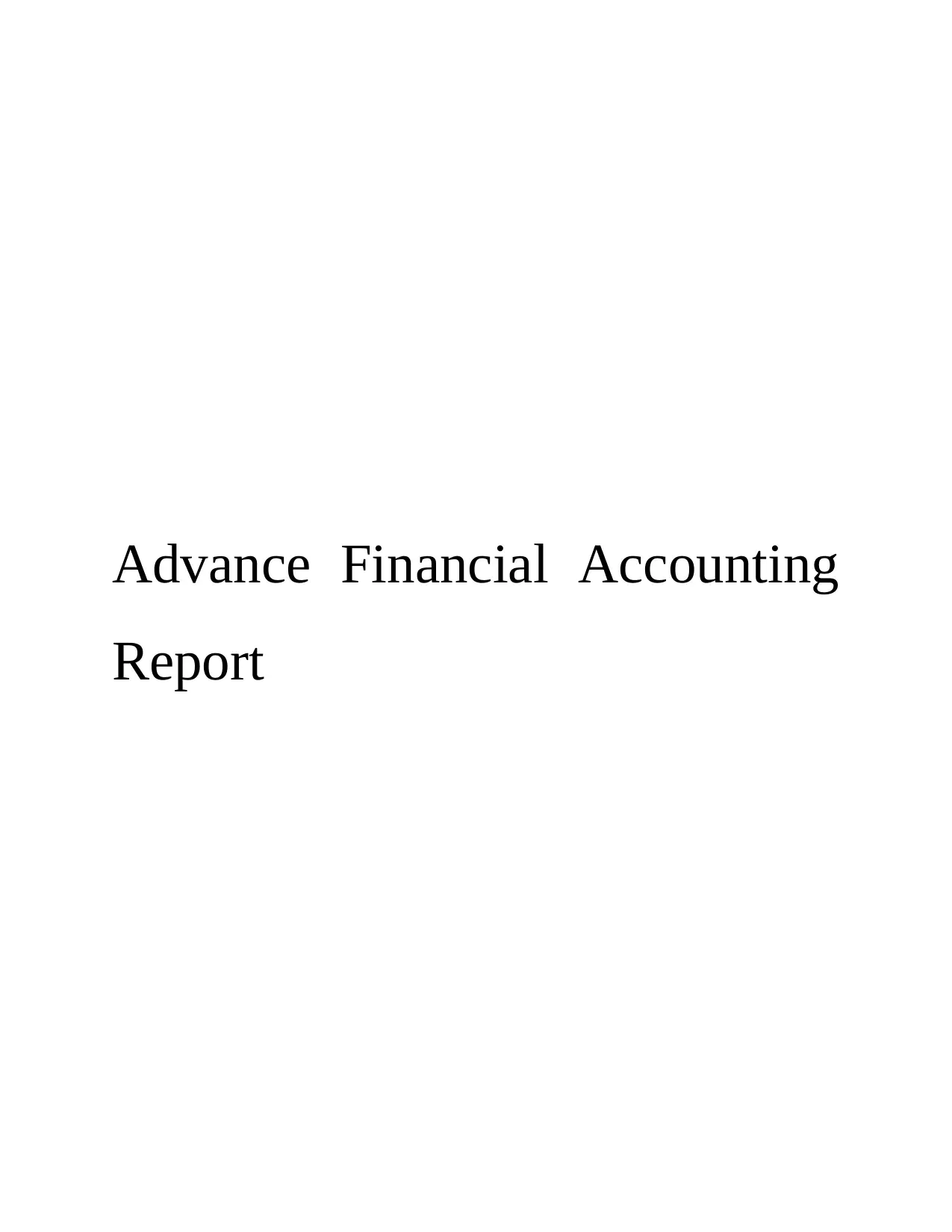
Advance Financial Accounting
Report
Report
Paraphrase This Document
Need a fresh take? Get an instant paraphrase of this document with our AI Paraphraser
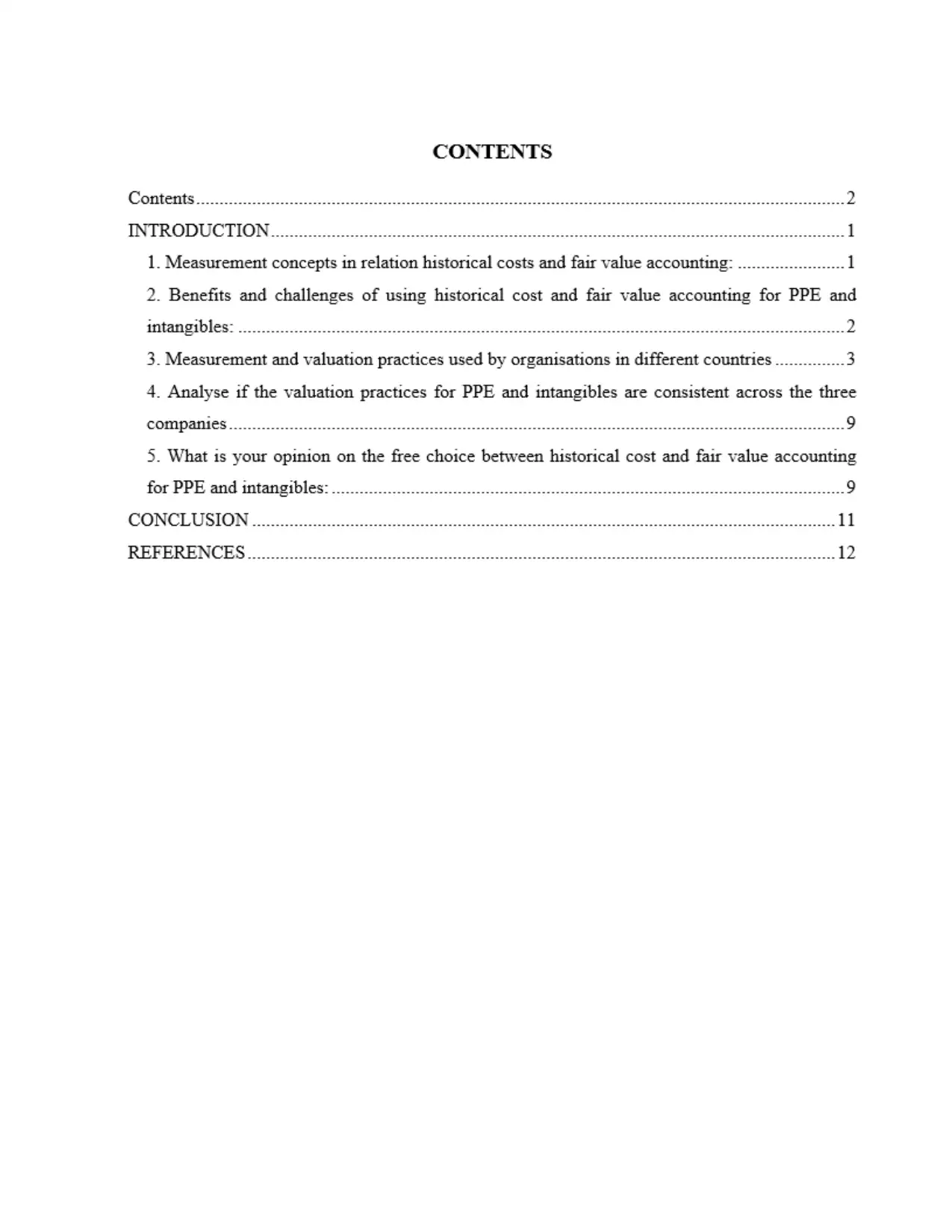

INTRODUCTION
The variety between fair value and historical cost accounting is the one which is highly
debated components in an accounting literature. While debate on these two topic started from
1930s, which is still disturbed (Macve, 2015). One disorder is move debate forward which is
deficiency of sign on the selection between these aforementioned accounting practices, when
selection a quasi-experiment rooted in the current essential consideration of the International
Financial Reporting Standard to learning the “market solution for selection between historical
cost and appropriate value accounting approaches. The current setting which exploits IFRS
implementation that has a precious distinction from Australia, UK, and US settings implemented
before going to have research. The selection between historical and fair value is that the
company is moving forward to make their business objectives in an effective manner (Rajgopal
and Venkatachalam, 2011).
1.
Fair value measurement implements to IFRSs which needs to enable FVM and renders a
individual IFRS framework for calculating fair value and needs releases about the FVM. The
Standard elaborates fair value on the basis of an “exit price’ notion and implements a “FVH”.
The standard elaborates fair value by relying of an “exit price” notion and implements a “fair
value hierarchy”, which emerge in the market based, instead of entity-specific, measurement.
The fair value hierarchy emerges to enhance reliability in the FVM and connected
releases via “FVH” the hierarchy classified the inputs applied in the valuation tools into three
levels (Hoyle, Schaefer and Doupnik, 2015). The hierarchy renders the maximum importance to
cited prices in active markets for resemble assets or liabilities and the lower priority to
unobservable inputs.
Measurement of fair value: The main aim of a FVM is to forecast the price under which an
arranged transaction to offer the asset or to transfer responsibility which will take place between
market participants during the measurement date as per the current market conditions. An
adequate value measurement needs an entity to elaborates of all of the below mentioned:
The particular asset or liability which is the subject of the measurement.
For a non-financial asset, valuation basis which is adequate for the measurement.
Principle market for the asset or liability.
1
The variety between fair value and historical cost accounting is the one which is highly
debated components in an accounting literature. While debate on these two topic started from
1930s, which is still disturbed (Macve, 2015). One disorder is move debate forward which is
deficiency of sign on the selection between these aforementioned accounting practices, when
selection a quasi-experiment rooted in the current essential consideration of the International
Financial Reporting Standard to learning the “market solution for selection between historical
cost and appropriate value accounting approaches. The current setting which exploits IFRS
implementation that has a precious distinction from Australia, UK, and US settings implemented
before going to have research. The selection between historical and fair value is that the
company is moving forward to make their business objectives in an effective manner (Rajgopal
and Venkatachalam, 2011).
1.
Fair value measurement implements to IFRSs which needs to enable FVM and renders a
individual IFRS framework for calculating fair value and needs releases about the FVM. The
Standard elaborates fair value on the basis of an “exit price’ notion and implements a “FVH”.
The standard elaborates fair value by relying of an “exit price” notion and implements a “fair
value hierarchy”, which emerge in the market based, instead of entity-specific, measurement.
The fair value hierarchy emerges to enhance reliability in the FVM and connected
releases via “FVH” the hierarchy classified the inputs applied in the valuation tools into three
levels (Hoyle, Schaefer and Doupnik, 2015). The hierarchy renders the maximum importance to
cited prices in active markets for resemble assets or liabilities and the lower priority to
unobservable inputs.
Measurement of fair value: The main aim of a FVM is to forecast the price under which an
arranged transaction to offer the asset or to transfer responsibility which will take place between
market participants during the measurement date as per the current market conditions. An
adequate value measurement needs an entity to elaborates of all of the below mentioned:
The particular asset or liability which is the subject of the measurement.
For a non-financial asset, valuation basis which is adequate for the measurement.
Principle market for the asset or liability.
1
⊘ This is a preview!⊘
Do you want full access?
Subscribe today to unlock all pages.

Trusted by 1+ million students worldwide
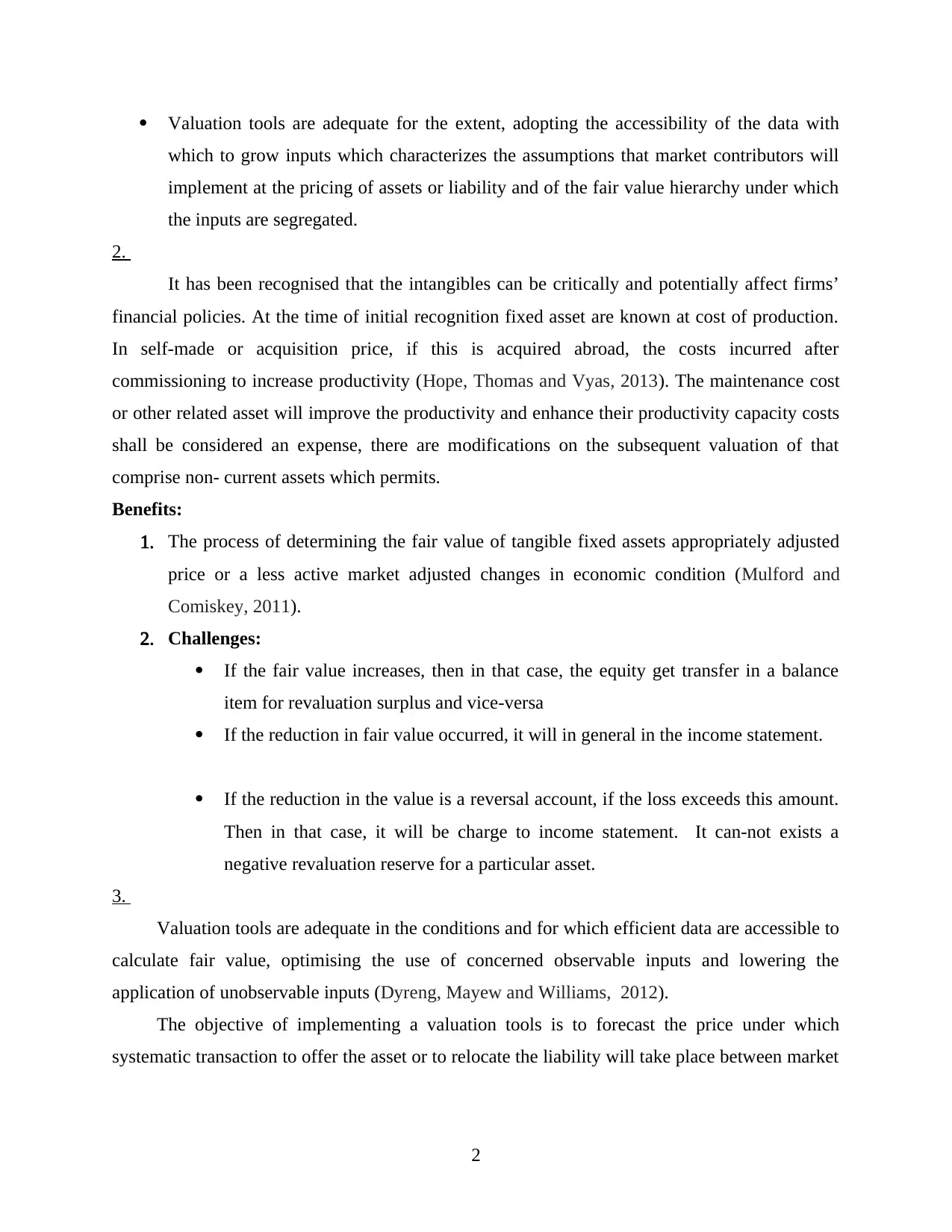
Valuation tools are adequate for the extent, adopting the accessibility of the data with
which to grow inputs which characterizes the assumptions that market contributors will
implement at the pricing of assets or liability and of the fair value hierarchy under which
the inputs are segregated.
2.
It has been recognised that the intangibles can be critically and potentially affect firms’
financial policies. At the time of initial recognition fixed asset are known at cost of production.
In self-made or acquisition price, if this is acquired abroad, the costs incurred after
commissioning to increase productivity (Hope, Thomas and Vyas, 2013). The maintenance cost
or other related asset will improve the productivity and enhance their productivity capacity costs
shall be considered an expense, there are modifications on the subsequent valuation of that
comprise non- current assets which permits.
Benefits:
1. The process of determining the fair value of tangible fixed assets appropriately adjusted
price or a less active market adjusted changes in economic condition (Mulford and
Comiskey, 2011).
2. Challenges:
If the fair value increases, then in that case, the equity get transfer in a balance
item for revaluation surplus and vice-versa
If the reduction in fair value occurred, it will in general in the income statement.
If the reduction in the value is a reversal account, if the loss exceeds this amount.
Then in that case, it will be charge to income statement. It can-not exists a
negative revaluation reserve for a particular asset.
3.
Valuation tools are adequate in the conditions and for which efficient data are accessible to
calculate fair value, optimising the use of concerned observable inputs and lowering the
application of unobservable inputs (Dyreng, Mayew and Williams, 2012).
The objective of implementing a valuation tools is to forecast the price under which
systematic transaction to offer the asset or to relocate the liability will take place between market
2
which to grow inputs which characterizes the assumptions that market contributors will
implement at the pricing of assets or liability and of the fair value hierarchy under which
the inputs are segregated.
2.
It has been recognised that the intangibles can be critically and potentially affect firms’
financial policies. At the time of initial recognition fixed asset are known at cost of production.
In self-made or acquisition price, if this is acquired abroad, the costs incurred after
commissioning to increase productivity (Hope, Thomas and Vyas, 2013). The maintenance cost
or other related asset will improve the productivity and enhance their productivity capacity costs
shall be considered an expense, there are modifications on the subsequent valuation of that
comprise non- current assets which permits.
Benefits:
1. The process of determining the fair value of tangible fixed assets appropriately adjusted
price or a less active market adjusted changes in economic condition (Mulford and
Comiskey, 2011).
2. Challenges:
If the fair value increases, then in that case, the equity get transfer in a balance
item for revaluation surplus and vice-versa
If the reduction in fair value occurred, it will in general in the income statement.
If the reduction in the value is a reversal account, if the loss exceeds this amount.
Then in that case, it will be charge to income statement. It can-not exists a
negative revaluation reserve for a particular asset.
3.
Valuation tools are adequate in the conditions and for which efficient data are accessible to
calculate fair value, optimising the use of concerned observable inputs and lowering the
application of unobservable inputs (Dyreng, Mayew and Williams, 2012).
The objective of implementing a valuation tools is to forecast the price under which
systematic transaction to offer the asset or to relocate the liability will take place between market
2
Paraphrase This Document
Need a fresh take? Get an instant paraphrase of this document with our AI Paraphraser

participants and measurement date as per the present market conditions. Basically, there are three
most common valuation techniques which are as follows:
Market approach: This approach uses prices and other concerned information produced
by the market transactions covering equal or comparable assets, liabilities.
Cost approach: This refers to the amount which will requires now to exchange the service
capacity of an asset (Francis and et.al., 2015).
Income approach: This changes future cash flows or expenses amount to an existing
amount, reflecting existing market prospects about those future amounts (Deegan, 2013).
In few of the cases, a single valuation tools would be more adequate, while on the hand, others
multiple valuation tools would be adequate.
Under this case, three companies are going to select from different stock exchanges as
this can be said that the one company will be selected from the ASX stock exchange which are
operates, second one is from the FTSE stock exchange, and third one is selected from the NYSE.
From UK FTSE market, Unilever plc is selected, while in NYSE market, American
power corporation is going to be selected. From the Australian market, BHP Billiton is selected.
By analysing the balance sheet of the firms’ a proper conclusion can be drawn in an effective
manner. however, this can be said that the company can use their techniques in an effective
manner. the definition of “fair value” is that which is applied to the highly adopted and disclosed
information which is calculated implementing fair value measurement in U.S.
Where disclosures are needed to be rendered for each class of assets or liability, a firm
identifies adequate classes on the basis of nature, characteristics and risks of the asset or liability,
and level of FVH under which the FVM is segregated.
Identifying an adequate class of assets and liabilities for which exposes about the FVM must
need to render judgement (Crawford and et.al., 2012). A class of assets and liabilities would
normally need disaggregation than the line items reflected in the statement of financial position.
There are few disclosures which are segregated on whether the measurements are:
Recurring fair value measurements- FVMs enables by other IFRSs which are to be
recognised in the statement of financial position at the end of each reporting period.
Non-recurring fair value measurements: These FVMs which are needed by other
IFRSs to be measured in the statement of financial position in a precise position.
(a) Valuation practices used by Unilever Plc listed under London Stock exchange
3
most common valuation techniques which are as follows:
Market approach: This approach uses prices and other concerned information produced
by the market transactions covering equal or comparable assets, liabilities.
Cost approach: This refers to the amount which will requires now to exchange the service
capacity of an asset (Francis and et.al., 2015).
Income approach: This changes future cash flows or expenses amount to an existing
amount, reflecting existing market prospects about those future amounts (Deegan, 2013).
In few of the cases, a single valuation tools would be more adequate, while on the hand, others
multiple valuation tools would be adequate.
Under this case, three companies are going to select from different stock exchanges as
this can be said that the one company will be selected from the ASX stock exchange which are
operates, second one is from the FTSE stock exchange, and third one is selected from the NYSE.
From UK FTSE market, Unilever plc is selected, while in NYSE market, American
power corporation is going to be selected. From the Australian market, BHP Billiton is selected.
By analysing the balance sheet of the firms’ a proper conclusion can be drawn in an effective
manner. however, this can be said that the company can use their techniques in an effective
manner. the definition of “fair value” is that which is applied to the highly adopted and disclosed
information which is calculated implementing fair value measurement in U.S.
Where disclosures are needed to be rendered for each class of assets or liability, a firm
identifies adequate classes on the basis of nature, characteristics and risks of the asset or liability,
and level of FVH under which the FVM is segregated.
Identifying an adequate class of assets and liabilities for which exposes about the FVM must
need to render judgement (Crawford and et.al., 2012). A class of assets and liabilities would
normally need disaggregation than the line items reflected in the statement of financial position.
There are few disclosures which are segregated on whether the measurements are:
Recurring fair value measurements- FVMs enables by other IFRSs which are to be
recognised in the statement of financial position at the end of each reporting period.
Non-recurring fair value measurements: These FVMs which are needed by other
IFRSs to be measured in the statement of financial position in a precise position.
(a) Valuation practices used by Unilever Plc listed under London Stock exchange
3

Balance sheet of Unilever Plc
4
4
⊘ This is a preview!⊘
Do you want full access?
Subscribe today to unlock all pages.

Trusted by 1+ million students worldwide
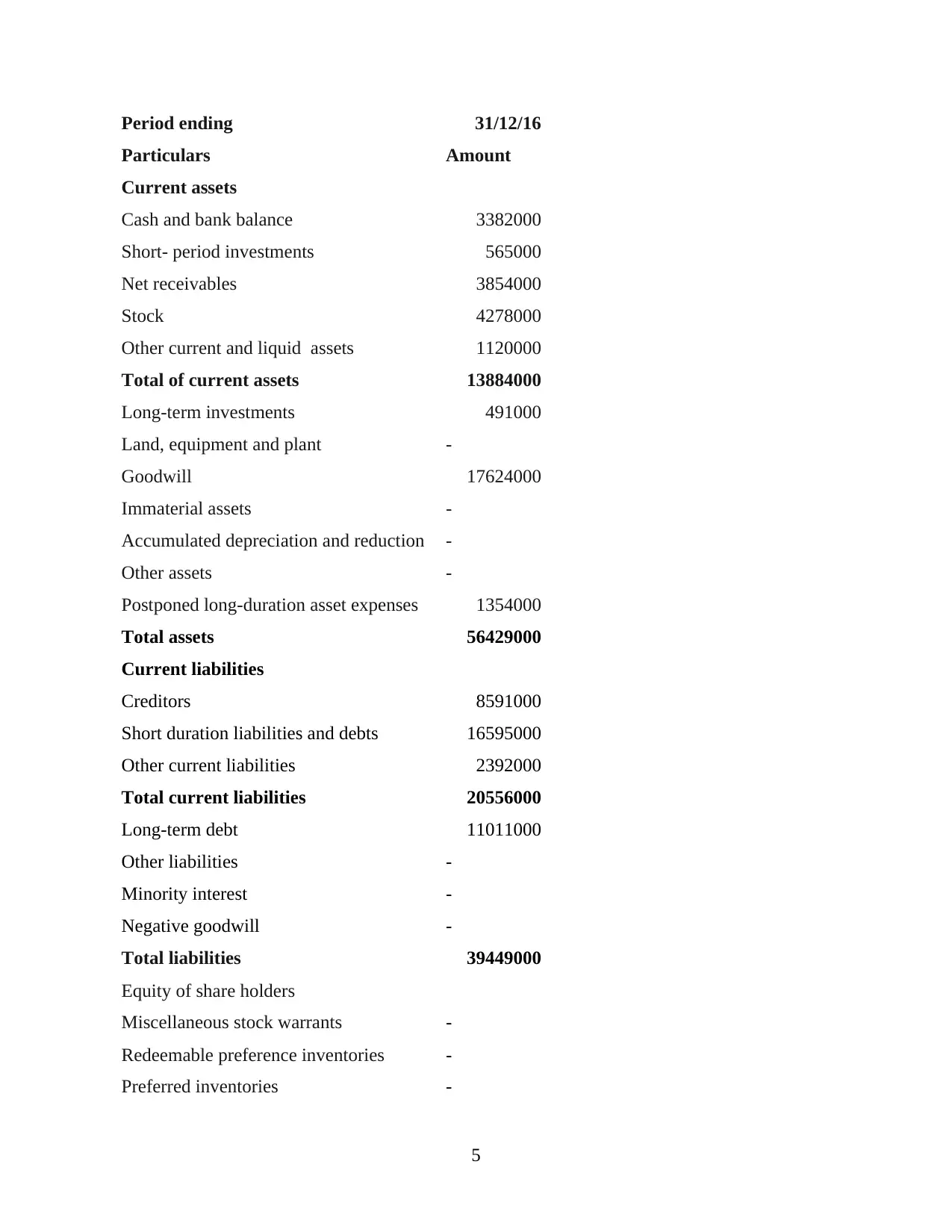
Period ending 31/12/16
Particulars Amount
Current assets
Cash and bank balance 3382000
Short- period investments 565000
Net receivables 3854000
Stock 4278000
Other current and liquid assets 1120000
Total of current assets 13884000
Long-term investments 491000
Land, equipment and plant -
Goodwill 17624000
Immaterial assets -
Accumulated depreciation and reduction -
Other assets -
Postponed long-duration asset expenses 1354000
Total assets 56429000
Current liabilities
Creditors 8591000
Short duration liabilities and debts 16595000
Other current liabilities 2392000
Total current liabilities 20556000
Long-term debt 11011000
Other liabilities -
Minority interest -
Negative goodwill -
Total liabilities 39449000
Equity of share holders
Miscellaneous stock warrants -
Redeemable preference inventories -
Preferred inventories -
5
Particulars Amount
Current assets
Cash and bank balance 3382000
Short- period investments 565000
Net receivables 3854000
Stock 4278000
Other current and liquid assets 1120000
Total of current assets 13884000
Long-term investments 491000
Land, equipment and plant -
Goodwill 17624000
Immaterial assets -
Accumulated depreciation and reduction -
Other assets -
Postponed long-duration asset expenses 1354000
Total assets 56429000
Current liabilities
Creditors 8591000
Short duration liabilities and debts 16595000
Other current liabilities 2392000
Total current liabilities 20556000
Long-term debt 11011000
Other liabilities -
Minority interest -
Negative goodwill -
Total liabilities 39449000
Equity of share holders
Miscellaneous stock warrants -
Redeemable preference inventories -
Preferred inventories -
5
Paraphrase This Document
Need a fresh take? Get an instant paraphrase of this document with our AI Paraphraser
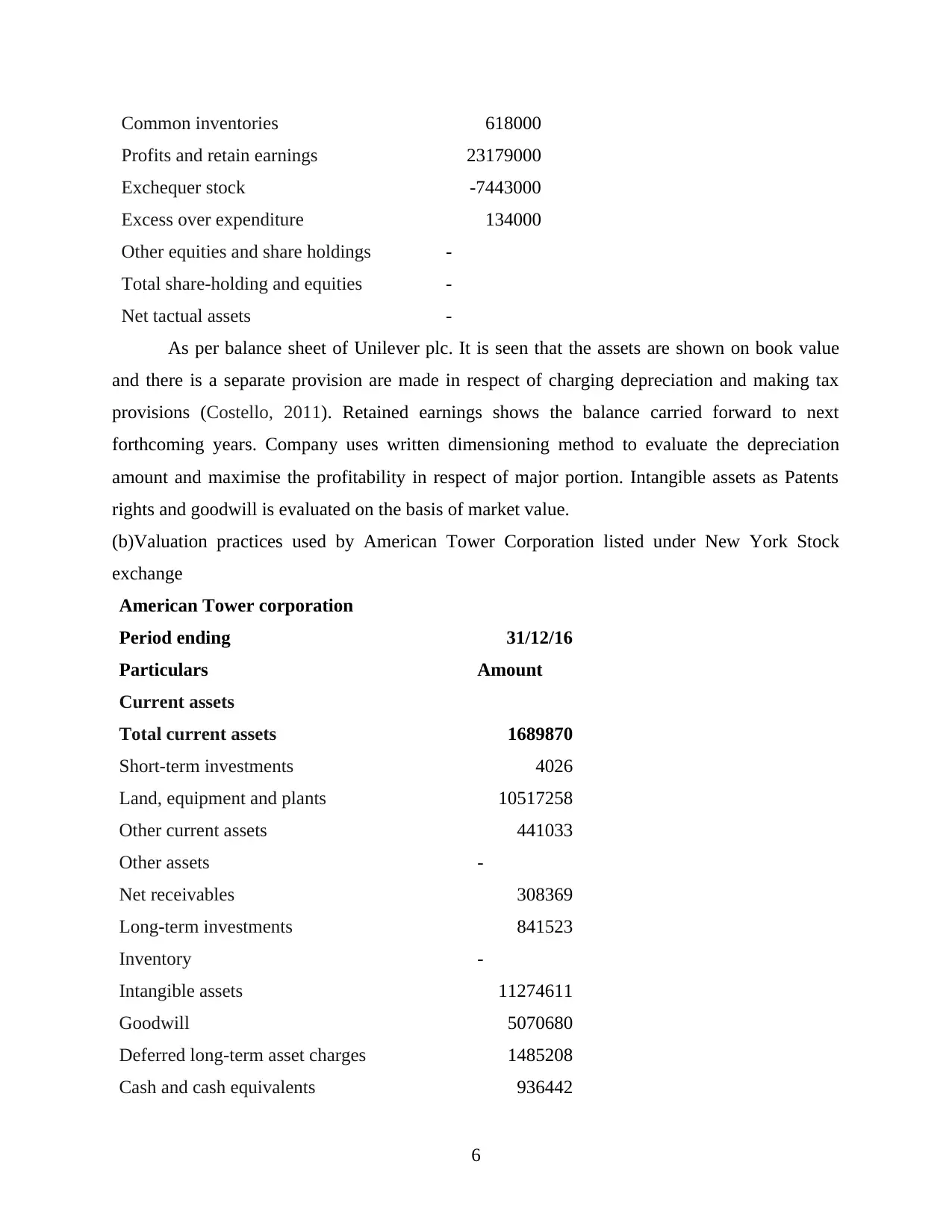
Common inventories 618000
Profits and retain earnings 23179000
Exchequer stock -7443000
Excess over expenditure 134000
Other equities and share holdings -
Total share-holding and equities -
Net tactual assets -
As per balance sheet of Unilever plc. It is seen that the assets are shown on book value
and there is a separate provision are made in respect of charging depreciation and making tax
provisions (Costello, 2011). Retained earnings shows the balance carried forward to next
forthcoming years. Company uses written dimensioning method to evaluate the depreciation
amount and maximise the profitability in respect of major portion. Intangible assets as Patents
rights and goodwill is evaluated on the basis of market value.
(b)Valuation practices used by American Tower Corporation listed under New York Stock
exchange
American Tower corporation
Period ending 31/12/16
Particulars Amount
Current assets
Total current assets 1689870
Short-term investments 4026
Land, equipment and plants 10517258
Other current assets 441033
Other assets -
Net receivables 308369
Long-term investments 841523
Inventory -
Intangible assets 11274611
Goodwill 5070680
Deferred long-term asset charges 1485208
Cash and cash equivalents 936442
6
Profits and retain earnings 23179000
Exchequer stock -7443000
Excess over expenditure 134000
Other equities and share holdings -
Total share-holding and equities -
Net tactual assets -
As per balance sheet of Unilever plc. It is seen that the assets are shown on book value
and there is a separate provision are made in respect of charging depreciation and making tax
provisions (Costello, 2011). Retained earnings shows the balance carried forward to next
forthcoming years. Company uses written dimensioning method to evaluate the depreciation
amount and maximise the profitability in respect of major portion. Intangible assets as Patents
rights and goodwill is evaluated on the basis of market value.
(b)Valuation practices used by American Tower Corporation listed under New York Stock
exchange
American Tower corporation
Period ending 31/12/16
Particulars Amount
Current assets
Total current assets 1689870
Short-term investments 4026
Land, equipment and plants 10517258
Other current assets 441033
Other assets -
Net receivables 308369
Long-term investments 841523
Inventory -
Intangible assets 11274611
Goodwill 5070680
Deferred long-term asset charges 1485208
Cash and cash equivalents 936442
6
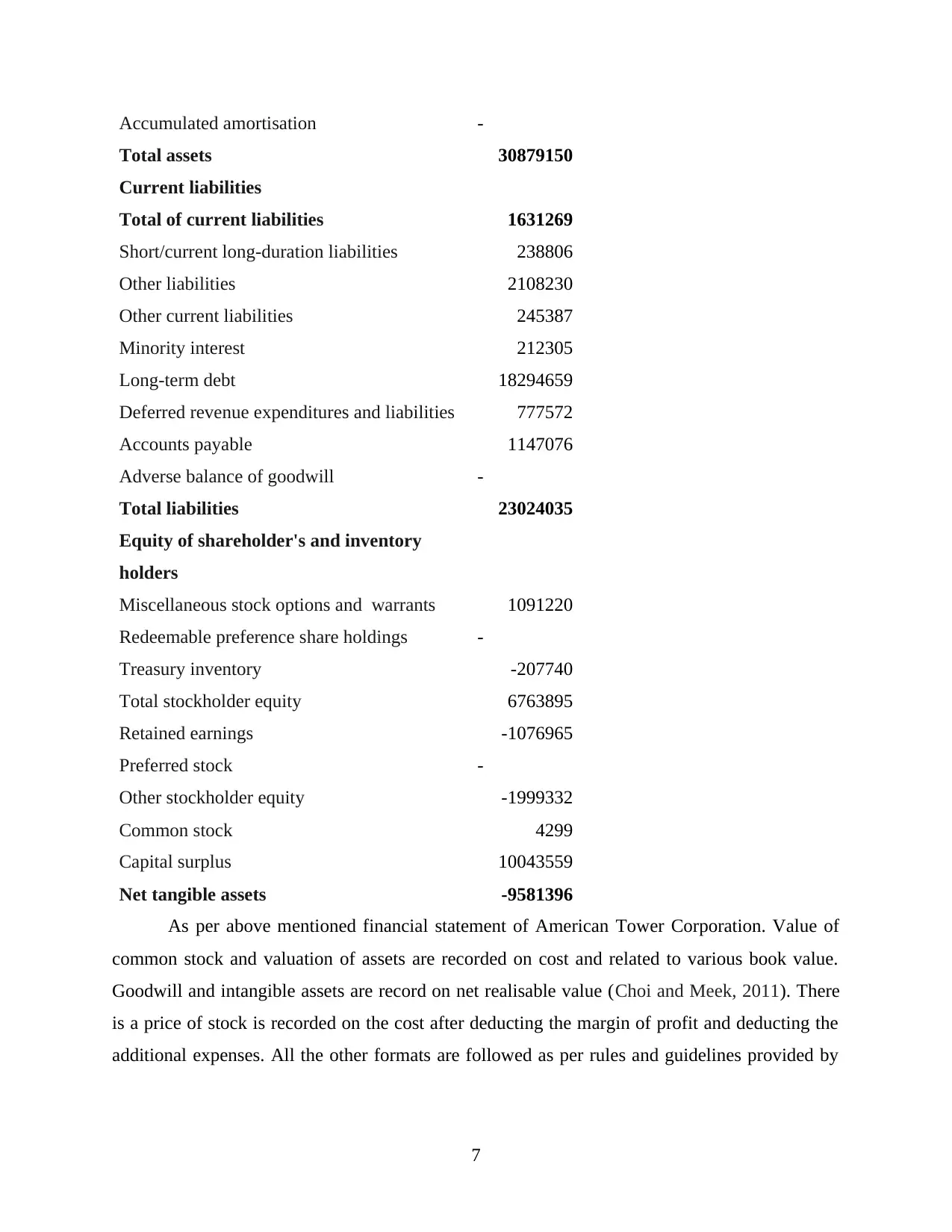
Accumulated amortisation -
Total assets 30879150
Current liabilities
Total of current liabilities 1631269
Short/current long-duration liabilities 238806
Other liabilities 2108230
Other current liabilities 245387
Minority interest 212305
Long-term debt 18294659
Deferred revenue expenditures and liabilities 777572
Accounts payable 1147076
Adverse balance of goodwill -
Total liabilities 23024035
Equity of shareholder's and inventory
holders
Miscellaneous stock options and warrants 1091220
Redeemable preference share holdings -
Treasury inventory -207740
Total stockholder equity 6763895
Retained earnings -1076965
Preferred stock -
Other stockholder equity -1999332
Common stock 4299
Capital surplus 10043559
Net tangible assets -9581396
As per above mentioned financial statement of American Tower Corporation. Value of
common stock and valuation of assets are recorded on cost and related to various book value.
Goodwill and intangible assets are record on net realisable value (Choi and Meek, 2011). There
is a price of stock is recorded on the cost after deducting the margin of profit and deducting the
additional expenses. All the other formats are followed as per rules and guidelines provided by
7
Total assets 30879150
Current liabilities
Total of current liabilities 1631269
Short/current long-duration liabilities 238806
Other liabilities 2108230
Other current liabilities 245387
Minority interest 212305
Long-term debt 18294659
Deferred revenue expenditures and liabilities 777572
Accounts payable 1147076
Adverse balance of goodwill -
Total liabilities 23024035
Equity of shareholder's and inventory
holders
Miscellaneous stock options and warrants 1091220
Redeemable preference share holdings -
Treasury inventory -207740
Total stockholder equity 6763895
Retained earnings -1076965
Preferred stock -
Other stockholder equity -1999332
Common stock 4299
Capital surplus 10043559
Net tangible assets -9581396
As per above mentioned financial statement of American Tower Corporation. Value of
common stock and valuation of assets are recorded on cost and related to various book value.
Goodwill and intangible assets are record on net realisable value (Choi and Meek, 2011). There
is a price of stock is recorded on the cost after deducting the margin of profit and deducting the
additional expenses. All the other formats are followed as per rules and guidelines provided by
7
⊘ This is a preview!⊘
Do you want full access?
Subscribe today to unlock all pages.

Trusted by 1+ million students worldwide
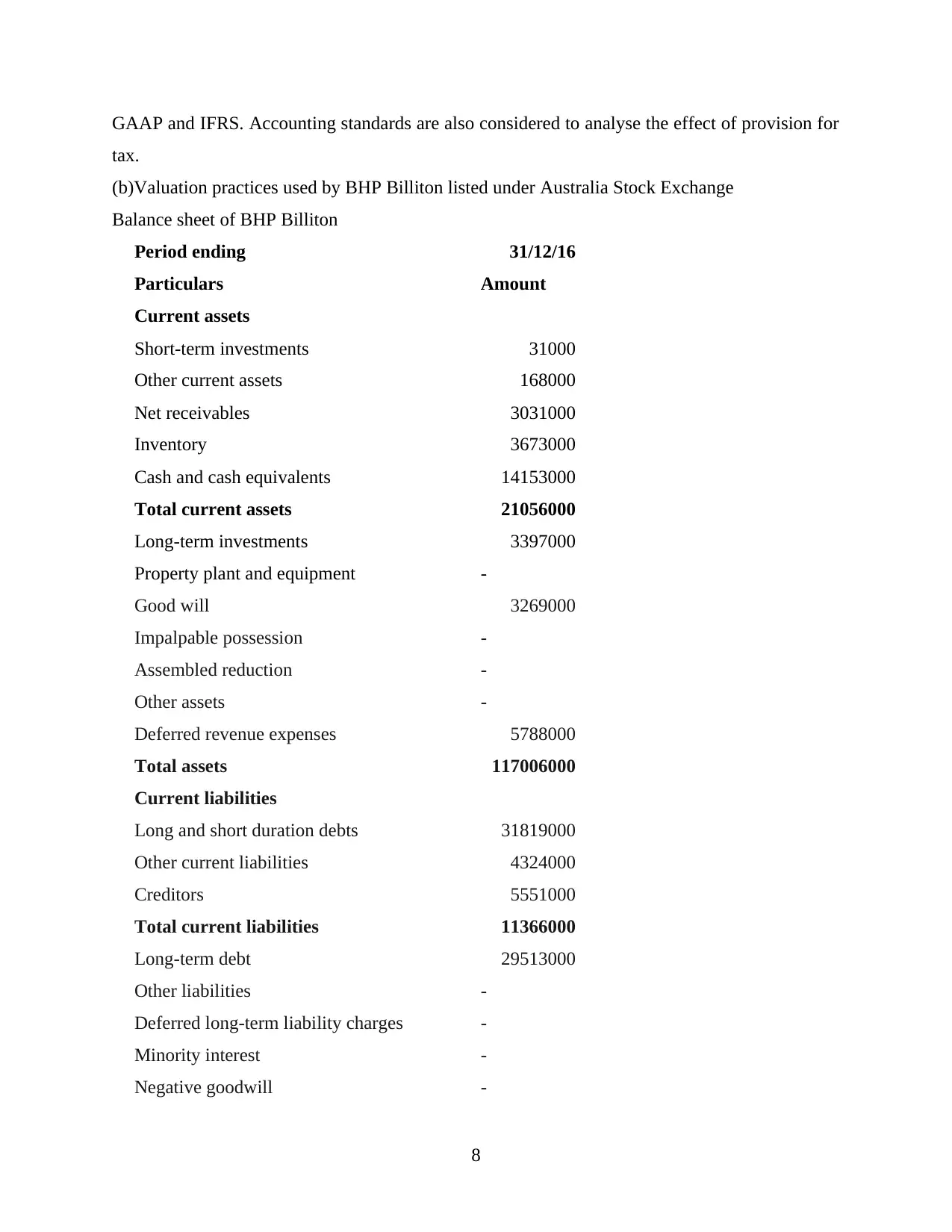
GAAP and IFRS. Accounting standards are also considered to analyse the effect of provision for
tax.
(b)Valuation practices used by BHP Billiton listed under Australia Stock Exchange
Balance sheet of BHP Billiton
Period ending 31/12/16
Particulars Amount
Current assets
Short-term investments 31000
Other current assets 168000
Net receivables 3031000
Inventory 3673000
Cash and cash equivalents 14153000
Total current assets 21056000
Long-term investments 3397000
Property plant and equipment -
Good will 3269000
Impalpable possession -
Assembled reduction -
Other assets -
Deferred revenue expenses 5788000
Total assets 117006000
Current liabilities
Long and short duration debts 31819000
Other current liabilities 4324000
Creditors 5551000
Total current liabilities 11366000
Long-term debt 29513000
Other liabilities -
Deferred long-term liability charges -
Minority interest -
Negative goodwill -
8
tax.
(b)Valuation practices used by BHP Billiton listed under Australia Stock Exchange
Balance sheet of BHP Billiton
Period ending 31/12/16
Particulars Amount
Current assets
Short-term investments 31000
Other current assets 168000
Net receivables 3031000
Inventory 3673000
Cash and cash equivalents 14153000
Total current assets 21056000
Long-term investments 3397000
Property plant and equipment -
Good will 3269000
Impalpable possession -
Assembled reduction -
Other assets -
Deferred revenue expenses 5788000
Total assets 117006000
Current liabilities
Long and short duration debts 31819000
Other current liabilities 4324000
Creditors 5551000
Total current liabilities 11366000
Long-term debt 29513000
Other liabilities -
Deferred long-term liability charges -
Minority interest -
Negative goodwill -
8
Paraphrase This Document
Need a fresh take? Get an instant paraphrase of this document with our AI Paraphraser

Total liabilities 54280000
Treasury inventories 1879000
Shareholders' and stock holders' equity
Retained earnings 52618000
Redeemable preference share holdings and
stock -
Preference inventories -
Miscellaneous shareholdings and options
warrants -
Common inventories 2761000
Capital excess over expenditure 815000
Other stockholder equity -
Total stockholder equity -
Net tangible assets -
As per above financial statement of BHP Billton treasury stock is calculated on cost and
all other expense are counted on accrual basis rather then actual basis. Organisation is following
the rules and guidelines provided by GAAP and international standards for Accounting. There is
straight line method is used to evaluate the depreciation on assets.
4.
Analysis of Uniliver Plc.: As per financial reports and accounting reports there are few
certain points which remain come in practice. As the financial records the assets and liabilities
are not being carry forwarded for more than one year (Chen and et.al., 2011). All the changes are
made in the end of financial year and all the adjustments are done in respect of fixed assets and
goodwill. As per the financial report the cost of sales and profit is evaluated after deducting the
cost of additional expenses.
Analysis of American Tower Corporation: Plant, patents and machinery are evaluated on
net realisable value. As per accounting rule of ISA 1 disclosure policies all the policies and
procedures should be defined in annual financial and accounting reports. There must know any
kind of short term liabilities should be treated as long term prospective. Organisation is
consistent in respect of following the procedure and policies reading provisions for bad debts and
liabilities. Existence concept is clearly defined in its financial reports which indicates towards the
9
Treasury inventories 1879000
Shareholders' and stock holders' equity
Retained earnings 52618000
Redeemable preference share holdings and
stock -
Preference inventories -
Miscellaneous shareholdings and options
warrants -
Common inventories 2761000
Capital excess over expenditure 815000
Other stockholder equity -
Total stockholder equity -
Net tangible assets -
As per above financial statement of BHP Billton treasury stock is calculated on cost and
all other expense are counted on accrual basis rather then actual basis. Organisation is following
the rules and guidelines provided by GAAP and international standards for Accounting. There is
straight line method is used to evaluate the depreciation on assets.
4.
Analysis of Uniliver Plc.: As per financial reports and accounting reports there are few
certain points which remain come in practice. As the financial records the assets and liabilities
are not being carry forwarded for more than one year (Chen and et.al., 2011). All the changes are
made in the end of financial year and all the adjustments are done in respect of fixed assets and
goodwill. As per the financial report the cost of sales and profit is evaluated after deducting the
cost of additional expenses.
Analysis of American Tower Corporation: Plant, patents and machinery are evaluated on
net realisable value. As per accounting rule of ISA 1 disclosure policies all the policies and
procedures should be defined in annual financial and accounting reports. There must know any
kind of short term liabilities should be treated as long term prospective. Organisation is
consistent in respect of following the procedure and policies reading provisions for bad debts and
liabilities. Existence concept is clearly defined in its financial reports which indicates towards the
9
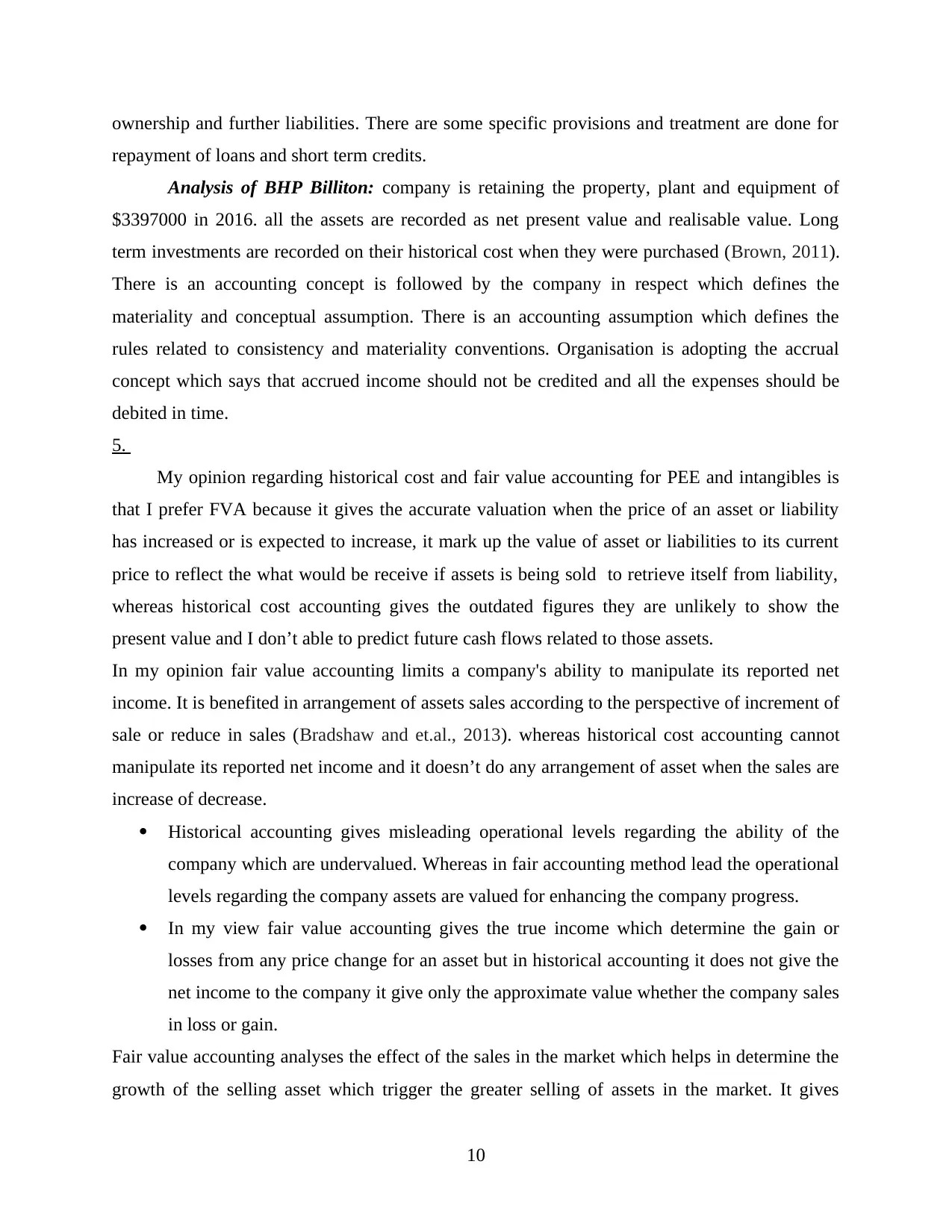
ownership and further liabilities. There are some specific provisions and treatment are done for
repayment of loans and short term credits.
Analysis of BHP Billiton: company is retaining the property, plant and equipment of
$3397000 in 2016. all the assets are recorded as net present value and realisable value. Long
term investments are recorded on their historical cost when they were purchased (Brown, 2011).
There is an accounting concept is followed by the company in respect which defines the
materiality and conceptual assumption. There is an accounting assumption which defines the
rules related to consistency and materiality conventions. Organisation is adopting the accrual
concept which says that accrued income should not be credited and all the expenses should be
debited in time.
5.
My opinion regarding historical cost and fair value accounting for PEE and intangibles is
that I prefer FVA because it gives the accurate valuation when the price of an asset or liability
has increased or is expected to increase, it mark up the value of asset or liabilities to its current
price to reflect the what would be receive if assets is being sold to retrieve itself from liability,
whereas historical cost accounting gives the outdated figures they are unlikely to show the
present value and I don’t able to predict future cash flows related to those assets.
In my opinion fair value accounting limits a company's ability to manipulate its reported net
income. It is benefited in arrangement of assets sales according to the perspective of increment of
sale or reduce in sales (Bradshaw and et.al., 2013). whereas historical cost accounting cannot
manipulate its reported net income and it doesn’t do any arrangement of asset when the sales are
increase of decrease.
Historical accounting gives misleading operational levels regarding the ability of the
company which are undervalued. Whereas in fair accounting method lead the operational
levels regarding the company assets are valued for enhancing the company progress.
In my view fair value accounting gives the true income which determine the gain or
losses from any price change for an asset but in historical accounting it does not give the
net income to the company it give only the approximate value whether the company sales
in loss or gain.
Fair value accounting analyses the effect of the sales in the market which helps in determine the
growth of the selling asset which trigger the greater selling of assets in the market. It gives
10
repayment of loans and short term credits.
Analysis of BHP Billiton: company is retaining the property, plant and equipment of
$3397000 in 2016. all the assets are recorded as net present value and realisable value. Long
term investments are recorded on their historical cost when they were purchased (Brown, 2011).
There is an accounting concept is followed by the company in respect which defines the
materiality and conceptual assumption. There is an accounting assumption which defines the
rules related to consistency and materiality conventions. Organisation is adopting the accrual
concept which says that accrued income should not be credited and all the expenses should be
debited in time.
5.
My opinion regarding historical cost and fair value accounting for PEE and intangibles is
that I prefer FVA because it gives the accurate valuation when the price of an asset or liability
has increased or is expected to increase, it mark up the value of asset or liabilities to its current
price to reflect the what would be receive if assets is being sold to retrieve itself from liability,
whereas historical cost accounting gives the outdated figures they are unlikely to show the
present value and I don’t able to predict future cash flows related to those assets.
In my opinion fair value accounting limits a company's ability to manipulate its reported net
income. It is benefited in arrangement of assets sales according to the perspective of increment of
sale or reduce in sales (Bradshaw and et.al., 2013). whereas historical cost accounting cannot
manipulate its reported net income and it doesn’t do any arrangement of asset when the sales are
increase of decrease.
Historical accounting gives misleading operational levels regarding the ability of the
company which are undervalued. Whereas in fair accounting method lead the operational
levels regarding the company assets are valued for enhancing the company progress.
In my view fair value accounting gives the true income which determine the gain or
losses from any price change for an asset but in historical accounting it does not give the
net income to the company it give only the approximate value whether the company sales
in loss or gain.
Fair value accounting analyses the effect of the sales in the market which helps in determine the
growth of the selling asset which trigger the greater selling of assets in the market. It gives
10
⊘ This is a preview!⊘
Do you want full access?
Subscribe today to unlock all pages.

Trusted by 1+ million students worldwide
1 out of 13
Related Documents
Your All-in-One AI-Powered Toolkit for Academic Success.
+13062052269
info@desklib.com
Available 24*7 on WhatsApp / Email
![[object Object]](/_next/static/media/star-bottom.7253800d.svg)
Unlock your academic potential
Copyright © 2020–2026 A2Z Services. All Rights Reserved. Developed and managed by ZUCOL.





